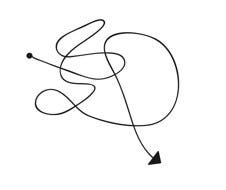This is, Quite Literally, What a Personal Essay Looks Like
In this visual guide from Creative Nonfiction magazine, learn about the basic "shapes" of memoir writing—and achieve a more personal, unique result in your work.
I like to draw my students’ essays on the classroom blackboard. Beginning writers are surprised to see their writing represented this way, rendered by my sloppy hand, reflected back at them as a squiggly line, a series of hills, two boxes next to one another, representing the two major movements in the essay. We can talk all we want in workshop about how an essay behaves, but I think seeing the journey an essay takes a reader on is key to thinking through revision. I’ve been teaching this Tim Bascom essay the last few semesters to students who have been through at least one round of workshopping an early draft. Bascom’s essay takes writers who are between drafts through a two-part process: First, students can see which of the structures posited most closely matches their draft. Then, they can scope out other shapes they’d like to try, either in revision or in a future essay. Many of us first write in the form that most closely mirrors how our minds and memory work. Bascom’s essay gives students language to speak about which shapes their impulses lead them toward and which shapes they aspire to try as they hone their craft. It also gives them a tidy reading list to take with them into future personal essay adventures, winding as they are.
—Krys Malcolm Belc, Edelstein-Keller Writer in Residence at the University of Minnesota
A design professor from Denmark once drew for me a picture of the creative process, which had been the subject of his doctoral dissertation. “Here,” he said. “This is what it looks like”:
Aha, I thought, as we discussed parallels in the writing process. Although I may start an essay with a notion of where I am headed, inevitably I veer away as I get new ideas or encounter dead ends. Sometimes I even seem to go backward, losing all direction.
Nothing is wasted though, said the design professor, because every bend in the process is helping you to arrive at your necessary structure. By trying a different angle or creating a composite of past approaches, you get closer and closer to what you intend. You begin to delineate the organic form that will match your content.
The remarkable thing about personal essays, which openly mimic this exploratory process, is that they can be so quirky in their “shape.” No diagram matches the exact form that evolves, and that is because the best essayists resist predictable approaches. They refuse to limit themselves to generic forms, which, like mannequins, can be tricked out in personal clothing. Nevertheless, recognizing a few basic underlying structures may help an essay writer invent a more personal, more unique form. Here, then, are several main options.



